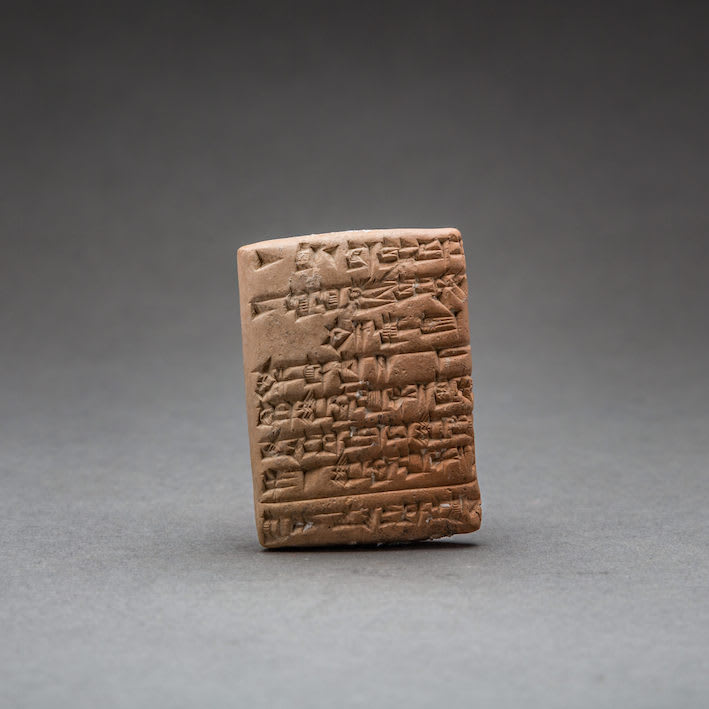Sumerian Cuneiform Tablet, 2034 BCE
Clay
1.81 x 2.51
CT.035
Sumerian Cuneiform is one of the earliest known forms of written expression. First appearing in the 4th millennium BC in what is now Iraq, it was dubbed cuneiform (“wedge-shaped”) because...
Sumerian Cuneiform is one of the earliest known forms of written expression. First appearing in the 4th millennium BC in what is now Iraq, it was dubbed cuneiform (“wedge-shaped”) because of the distinctive wedge form of the letters, created by pressing a reed stylus into wet clay. Early Sumerian writings were essentially pictograms, which became simplified in the early and mid 3rd millennium BC to a series of strokes, along with a commensurate reduction in the number of discrete signs used (from c.1500 to 600). The script system had a very long life and was used by the Sumerians as well as numerous later groups – notably the Assyrians, Elamites, Akkadians and Hittites – for around three thousand years. Certain signs and phonetic standards live on in modern languages of the Middle and Far East, but the writing system is essentially extinct. It was therefore cause for great excitement when the ‘code’ of ancient cuneiform was cracked by a group of English, French and German Assyriologists and philologists in the mid 19th century AD. This opened up a vital source of information about these ancient groups that could not have been obtained in any other way.
Cuneiform was used on monuments dedicated to heroic – and usually royal – individuals, but perhaps its most important function was that of record keeping. The palace-based society at Ur and other large urban centres was accompanied by a remarkably complex and multifaceted bureaucracy, which was run by professional administrators and a priestly class, all of whom were answerable to central court control. Most of what we know about the way the culture was run and administered comes from cuneiform tablets, which record the everyday running of the temple and palace complexes in minute detail, as in the present case. The Barakat Gallery has secured the services of Professor Lambert (University of Birmingham), a renowned expert in the decipherment and translation of cuneiform, to examine and process the information on these tablets. The following is a transcription of his analysis of this tablet:
This tablet consists of 16 lines of Sumerian cuneiform. It is perfectly preserved with finely written document recording the issuing of barley as wages to two men. It is dated to the 4th year of Shu-Sin, fourth king of the Third Dynasty of Ur, c. 2034 BC.
Translation:
1 gur: Shu-Ishtar, son of Ur-kiri.
1 gur: Lallatum, son of a prostitute. Deleted from the documents, by order of Sharrum, Id, supervisor of castle, assistant of Ur-kiri and Bel-bani, foreman of 60: Sharrum-Id.
Total: 2 gur: the assistant of Bel-bani, totalled Sharum-Id, supervisor, took via Ur-mes, the governor.
Month: of the plow. Year Shu-Sin, king of Ur, built the Amarru wall, “That which keeps the Tidnum at bay”.
This is a brief note that two men had been paid, but were struck off the register of workers henceforth, with a more than usual documentation of the various officials and bureaucrats involved. A gur was about 250 litres, no small amount.
Cuneiform was used on monuments dedicated to heroic – and usually royal – individuals, but perhaps its most important function was that of record keeping. The palace-based society at Ur and other large urban centres was accompanied by a remarkably complex and multifaceted bureaucracy, which was run by professional administrators and a priestly class, all of whom were answerable to central court control. Most of what we know about the way the culture was run and administered comes from cuneiform tablets, which record the everyday running of the temple and palace complexes in minute detail, as in the present case. The Barakat Gallery has secured the services of Professor Lambert (University of Birmingham), a renowned expert in the decipherment and translation of cuneiform, to examine and process the information on these tablets. The following is a transcription of his analysis of this tablet:
This tablet consists of 16 lines of Sumerian cuneiform. It is perfectly preserved with finely written document recording the issuing of barley as wages to two men. It is dated to the 4th year of Shu-Sin, fourth king of the Third Dynasty of Ur, c. 2034 BC.
Translation:
1 gur: Shu-Ishtar, son of Ur-kiri.
1 gur: Lallatum, son of a prostitute. Deleted from the documents, by order of Sharrum, Id, supervisor of castle, assistant of Ur-kiri and Bel-bani, foreman of 60: Sharrum-Id.
Total: 2 gur: the assistant of Bel-bani, totalled Sharum-Id, supervisor, took via Ur-mes, the governor.
Month: of the plow. Year Shu-Sin, king of Ur, built the Amarru wall, “That which keeps the Tidnum at bay”.
This is a brief note that two men had been paid, but were struck off the register of workers henceforth, with a more than usual documentation of the various officials and bureaucrats involved. A gur was about 250 litres, no small amount.



